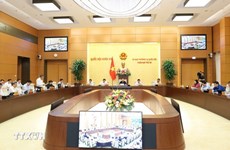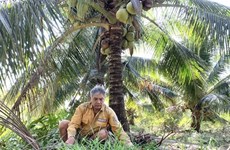Experts urge support for farmers
Experts on April 6 called for Vietnam to clarify policies that
support farmers and agriculture enterprises instead of putting too much
emphasis on growth targets.
Experts on April 6 called for Vietnam to clarify policies that
support farmers and agriculture enterprises instead of putting too much
emphasis on growth targets.
The call came as part of a draft proposal on restructuring the sector to become more sustainable and market-oriented by 2020.
Speaking at the consultation meeting, Minister of Agricultural Development and Rural Planning Cao Duc Phat acknowledged that despite years of rapid growth, the rate of agricultural GDP decreased from 4 percent annually in the period 1995-2000 to 3.83 percent in 2001-05 and 3.3 percent in 2006-10.
"The sector is quite vulnerable to diseases such as bird flu and natural disasters," he said.
In the proposal, the Ministry pointed out that agricultural production has been heavily reliant on crop production, a low investment rate that only amounted to 6.26 percent GDP in 2010, overexploitation of natural resources that go along with intensive farming and widening use of agro-chemicals, fertilisers, pesticides and growth stimulants.
It suggested the livestock, fishery, forestry and salt production sectors move to large-scale production, encourage private investment and public-private-partnerships, apply science and technology policies and provide preferable credit and loan policies.
Steve Jaffee, World Bank Rural Development sector co-ordinator, said government planners should only set strategic targets related to competitiveness, sustainability and innovation, not production goals.
"If you're moving toward a market-led approach, the market will decide whether it's 46 or 50 million tonnes. Both domestic and international consumers will make the decision," he said.
However, World Bank Country Director Victoria Kwawa said there is not enough "focus on the policy elements," particularly the kind of policies to encourage farmers and other small holders to increase value-added production.
Saying "the poor are left behind in the strategy," some participants argued that focus remained on growth instead of shifting to address how the sector will adapt to climate change, address the issue of food safety and the type of policy environment that encourages investors.
Nguyen Tri Ngoc, head of the MARD's Department of Crop Production, agreed that the Government's resolution issued in 2010 to encourage investment in agriculture basically did not yield any result after more than a year.
Vu Trong Binh, deputy head of the Institute of Policy and Strategy for Agriculture and Rural Development, said the proposal should move in the direction of restructuring based on regional production, increasing the quality of the supply chain and providing a fairer environment for public and private enterprises to access resources.
The proposal emphasised targets that go beyond the control of the MARD such as changes in world market prices, said Ari Kokko, professor at the Department of International Economics and Management of the Copenhagen Business School .
"I think it will be more appropriate if targets could be defined with reference to the variables that are actually controlled by the MARD," Kokko said. "This has to do with policies and inputs related to knowledge, infrastructure, credits, extension services, storage facilities, coordination of investments and so forth."
In his paper sent to the consultation meeting, professor David Dapice, chief economist for the Vietnam Programme at the John F. Kennedy School of Government, wrote that with respect to environmental threats to the Mekong Delta, too little may have been written in the proposal.
"The combination of falling ground water levels due to over-pumping, disrupted hydrology due to upstream dams and rising sea levels could severely damage the entire ecosystem," he explained. "It will be better to work on salt tolerant crops and fish raising systems as well as recharge of groundwater and raised beds for higher value crops."
Referring to the strategy as "top down, not bottom-up", Dapice stressed that the government should realise "the success of the targets depends on those who seem to be ignored."-VNA
The call came as part of a draft proposal on restructuring the sector to become more sustainable and market-oriented by 2020.
Speaking at the consultation meeting, Minister of Agricultural Development and Rural Planning Cao Duc Phat acknowledged that despite years of rapid growth, the rate of agricultural GDP decreased from 4 percent annually in the period 1995-2000 to 3.83 percent in 2001-05 and 3.3 percent in 2006-10.
"The sector is quite vulnerable to diseases such as bird flu and natural disasters," he said.
In the proposal, the Ministry pointed out that agricultural production has been heavily reliant on crop production, a low investment rate that only amounted to 6.26 percent GDP in 2010, overexploitation of natural resources that go along with intensive farming and widening use of agro-chemicals, fertilisers, pesticides and growth stimulants.
It suggested the livestock, fishery, forestry and salt production sectors move to large-scale production, encourage private investment and public-private-partnerships, apply science and technology policies and provide preferable credit and loan policies.
Steve Jaffee, World Bank Rural Development sector co-ordinator, said government planners should only set strategic targets related to competitiveness, sustainability and innovation, not production goals.
"If you're moving toward a market-led approach, the market will decide whether it's 46 or 50 million tonnes. Both domestic and international consumers will make the decision," he said.
However, World Bank Country Director Victoria Kwawa said there is not enough "focus on the policy elements," particularly the kind of policies to encourage farmers and other small holders to increase value-added production.
Saying "the poor are left behind in the strategy," some participants argued that focus remained on growth instead of shifting to address how the sector will adapt to climate change, address the issue of food safety and the type of policy environment that encourages investors.
Nguyen Tri Ngoc, head of the MARD's Department of Crop Production, agreed that the Government's resolution issued in 2010 to encourage investment in agriculture basically did not yield any result after more than a year.
Vu Trong Binh, deputy head of the Institute of Policy and Strategy for Agriculture and Rural Development, said the proposal should move in the direction of restructuring based on regional production, increasing the quality of the supply chain and providing a fairer environment for public and private enterprises to access resources.
The proposal emphasised targets that go beyond the control of the MARD such as changes in world market prices, said Ari Kokko, professor at the Department of International Economics and Management of the Copenhagen Business School .
"I think it will be more appropriate if targets could be defined with reference to the variables that are actually controlled by the MARD," Kokko said. "This has to do with policies and inputs related to knowledge, infrastructure, credits, extension services, storage facilities, coordination of investments and so forth."
In his paper sent to the consultation meeting, professor David Dapice, chief economist for the Vietnam Programme at the John F. Kennedy School of Government, wrote that with respect to environmental threats to the Mekong Delta, too little may have been written in the proposal.
"The combination of falling ground water levels due to over-pumping, disrupted hydrology due to upstream dams and rising sea levels could severely damage the entire ecosystem," he explained. "It will be better to work on salt tolerant crops and fish raising systems as well as recharge of groundwater and raised beds for higher value crops."
Referring to the strategy as "top down, not bottom-up", Dapice stressed that the government should realise "the success of the targets depends on those who seem to be ignored."-VNA













